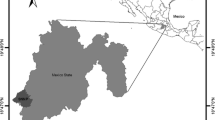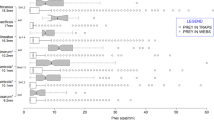Abstract
The community structure and polyspecific associations found in five sympatric resident primates (Cercopithecus nictitans, C. cephus, C. pogonias, Cercocebus torquatus, andC. albigena) and a temporary visitor (Mandrillus sphinx) were studied within the Campo Animal Reserve, a tropical rain forest in southwestern Cameroon. Several ecological variables of the six species, e.g. the number of foraging groups in the study area, group size, home range size, biomass density, and individual density, were estimated by undertaking a systematic census and by other means, e.g. tracing.C. nictitans was the most abundant species in terms of its foraging groups, biomass, and individual densities. The foraging biomass varied significantly among the six species. The five resident species frequently formed polyspecific groups.M. sphinx also associated with them when it visited the area. The food items fed on by the five resident species were also checked. An index for synecological analysis revealed that the five species shared similar food niches. The five species also utilized similar foraging areas and strata, possibly depending on the availabilities of common foods. The above results cannot be explained by conventional equilibrium-competition models. For understanding the polyspecific associations, it is proposed that the primates form polyspecific foraging groups in order to optimize their foraging biomass. This idea leads to a model that can also explain certain of the grouping behaviors, such as group fission-fusion, found in large body size primates.
Similar content being viewed by others
References
Cords, M., 1987.Mixed-Species Association of CercopithecusMonkeys in the Kakamega Forest, Kenya. Univ. of California Press, Berkeley.
Foster, R. B., 1982. The seasonal rhythm of fruitfall on Barro Colorado Island. In:The Ecology of a Tropical Forest,E. G. Leigh,Jr.,A. S. Rand, &D. M. Windsor (eds.), Smithsonian Institution Press, Washington, D.C., pp. 151–172.
Frankie, G. W., H. G. Baker, &P. A. Opler, 1974. Comparative phenological studies of trees in tropical wet and dry forests in the lowlands of Costa Rica.J. Ecol., 62: 881–919.
Gartlan, J. S. &T. T. Struhsaker, 1972. Polyspecific associations and niche separation of rainforest anthropoids in Cameroon, West Africa.J. Zool. Soc. London, 168: 221–266.
Gautier-Hion, A., 1975. Dimorphisme sexuel et organisation social chez les cercopithécinés forestiers africains.Mammalia, 39: 365–374.
———— &J.-P. Gautier, 1974. Les associations polyspécifiques de cercopithèques du Plateau de M'passa (Gabon).Folia Primatol., 22: 134–177.
———— & ————, 1976. Croissance, maturité sexuelle et sociale, reproduction chez les cercopithécinés forestiers africains.Folia Primatol., 26: 165–184.
———— & ————, 1979. Niche écologique et diversité des espèces sympatriques dans le genre cercopithécinés.Revue d'Écologie (Terre et Vie), 33: 493–507.
————,R. Quris, &J.-P. Gautier, 1983. Monospecific vs. polyspecific life: A comparative study of foraging and antipredatory tactics in a community ofCercopithecus monkeys.Behav. Ecol. Sociobiol., 12: 325–335.
Goodall, J., 1965. Chimpanzee of the Gombe Stream Reserve. In:Primate Behaviour,I. DeVore (ed.), Holt, Rinehart, & Winston, New York, pp. 425–473.
Hladik, C.-M., 1981. Diet and the evolution of feeding strategies among forest primates. In:Omnivorous Primates: Gathering and Hunting in Human Evolution,R. O. Harding &G. Teleki (eds.), Columbia Univ. Press, New York, pp. 215–254.
Homewood, K. M., 1978. Feeding strategy of the Tana mangabey (Cercocebus galeritus galeritus) (Mammalia: Primates).J. Zool. Soc. London, 186: 375–391.
Hubbell, S. P., 1979. Tree dispersion, abundance, and diversity in a tropical dry forest.Science, 203: 1299–1309.
Jones, C. &J. Sabater Pí, 1968. Comparative ecology ofCercocebus albigena (Gray) andCercocebus torquatus (Kerr) in Rio Muni, West Africa.Folia Primatol., 9: 99–113.
Kaji, M., 1985. Study on the floristic composition and the structure of tropical rain forests in south western Cameroon. In:Search for Useful Plants in Tropical Rain Forest in Cameroon, and Chemical Studies on Biologically Active Substances of the Plants,K. Koshimizu (ed.), Kyoto Univ., Kyoto, pp. 12–42.
Kudo, H., 1987. The study of vocal communication of wild mandrills in Cameroon in relation to their social structure.Primates, 28: 289–308.
Lack, D., 1971.Ecological Isolation in Birds. Blackwell Scientific Publications, Oxford, London, Edinburgh, Boston, & Melbourne.
Letouzey, R., 1968.Étude Phytogéographique du Cameroun. Éditions Paul Lechevalier, Paris.
Lotka, A. J., 1925.Elements of Physical Biology. Williams & Wilkins, Baltimore (Republished by Dover, New York).
MacArthur, R. H., 1958. Population ecology of some warblers of northeastern coniferous forests.Ecology, 39: 599–619.
Mitani, M., 1989.Cercocebus torquatus: Adaptive feeding and ranging behaviors related to seasonal fluctuations of food resources in the tropical rain forest of south-western Cameroon.Primates, 30: 307–323.
Morisita, M., 1959. Measuring of interspecific association and similarity between communities.Memoirs of the Faculty of Science, Kyushu University: Series E (Biology), 3: 65–80.
Pianka, E. R., 1975. Niche relation of desert lizards. In:Ecology and Evolution of Communities,M. L. Cody &J. M. Diamond (eds.), Harvard Univ. Press, Cambridge, pp. 292–314.
Pulliam, H. R. &T. Caraco, 1984. Living in groups: Is there an optimal group size? In:Behavioural Ecology: An Evolutionary Approach,J. R. Krebs &N. B. Davies (eds.), Blackwell Scientific Publications, Oxford, pp. 122–147.
Quris, R., 1975. Écologie et organisation social deCercocebus galeritus agilis dans le Nord-Est du Gabon.Revue d'Écologie (Terre et Vie), 29: 337–398.
Reynolds, V. &F. Reynolds, 1965. Chimpanzee of the Budongo forest. In:Primate Behaviour,I. DeVore (ed.), Holt, Rinehart, & Winston, New York, pp. 368–424.
Rijksen, H. D., 1978.A Field Study on Sumatran Orang Utans (Pongo pygmaeus abeliiLesson 1827),Ecology, Behaviour and Conservation. H. Veenman & Zonen B. V., Wageningen.
Simpson, E. H., 1949. Measurement of diversity.Nature, 163: 688.
Struhsaker, T. T., 1978. Food habits of five monkey species in the Kibale forest, Uganda. In:Recent Advances in Primatology, Vol. 1, Behaviour,D. J. Chivers &J. Herbert (eds.), Academic Press, London.
————, 1981. Polyspecific associations among tropical rain-forest primates.Zeitschrift für Tierpsychologie, 57: 268–304.
Sussman, R. &I. Tattersall, 1981. Behavior and ecology ofMacaca fuscicularis in Mauritius: A preliminary study.Primates, 22: 192–205.
Terborgh, J., 1983.New World Primates: A Study in Comparative Ecology. Princeton Univ. Press, Princeton.
Thorington, R. W., Jr., B. Tannenbaum, A. Tarak, &R. Rudran, 1982. Distribution of trees on Barro Colorado Island: A five hectare sample. In:The Ecology of a Tropical Forest,E. G. Leigh,Jr.,A. S. Rand, &D. M. Windsor (eds.), Smithsonian Inst. Press, Washington, D. C., pp. 83–94.
Volterra, M. V. &M. U. D'Ancona, 1935.Les Associations Biologiques: Au Point de Vue Mathématique. Hermann et Cie, Paris.
Waser, P. M., 1987. Interactions among primate species. In:Primate Societies,B. B. Smuts,D. L. Cheney,R. M. Seyfarth,R. W. Wrangham, &T. T. Struhsaker (eds.), The Univ. of Chicago Press, Chicago, pp. 210–226.
Author information
Authors and Affiliations
About this article
Cite this article
Mitani, M. Niche overlap and polyspecific associations among sympatric cercopithecids in the campo animal reserve, Southwestern Cameroon. Primates 32, 137–151 (1991). https://doi.org/10.1007/BF02381172
Received:
Accepted:
Issue Date:
DOI: https://doi.org/10.1007/BF02381172




